
Payroll Year-end Checklist
Carefully review the information stored in the Pay Codes table. The application uses the pay codes stored in the Pay Code table to calculate employee and employer amounts on quarterly reports, annual reports, W-2s, and so on.
Videos
In this Topic Hide
Step 2: Verify the pay code information
A. Verify pay code rates and limits
First, check the Social Security Rates/Limits on the Employee and Employer tabs
Second, check the Medicare Rates/Limits on the Employee and Employer tabs
Third, check any other limits that may apply
C. Verify IDs for Federal and State pay codes
First, verify the Federal ID number
Second, verify the State Tax ID Number
D. Review the Subject To pay codes
Check the pay codes subject to Social Security
Check the pay codes subject to Medicare
Check the pay codes subject to Federal Withholding Tax
Check the pay codes subject to State Withholding Tax
E. Verify W-2 box 10, 11, 12, and 14 settings
Make sure that the current rate/limit information is correctly set up in pay codes for the payroll year being closed.
You’ll need to...
Look up the Social Security rates and limits to make sure the rates and amounts are correct.
Do this...
1. Open Connect Payroll > Organization > Pay Codes.
2. Enter the Social Security Pay Code for your site in the Lookup bar.
Example: 74-00 Social Security
3. Press Enter.
4. Click the Employee tab > Employee subtab.
5. Verify the amount in the Maximum Wage Limit field is correct for the payroll year being closed.

Employee tab > Maximum Wage Limit field
6. Verify the number in the Amount/Rate/Percent Type field is correct for the payroll year being closed.
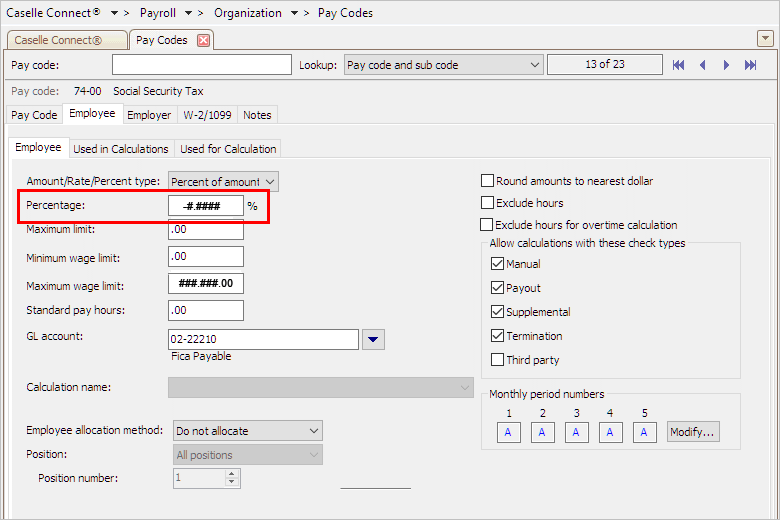
Employee tab > Percentage field
7. Click the Employer tab > Employer subtab.
8. Verify the amount in the Maximum Wage Limit field is correct for the payroll year being closed.
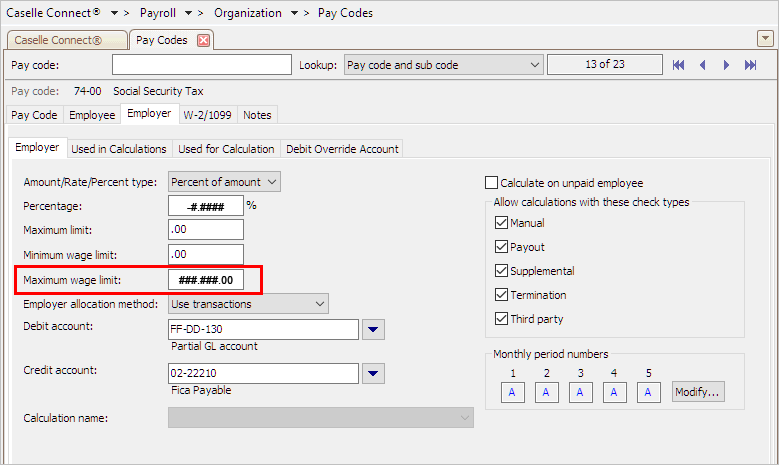
Employer tab > Maximum Wage Limit field
9. Verify the number in the Amount/Rate/Percent Type field is correct for the payroll year being closed.

Employer tab > Percentage field
IMPORTANT! Place the tax rate information for the coming year in a safe place. DO NOT load the new tax rate information into Payroll until Step 7: Finishing up.
The Social Security Rates/Limits are verified.
Updated 19Dec2017
Look up the Medicare rates and limits to make sure the rates and amounts are correct.
Do this...
1. Open Connect Payroll > Organization > Pay Codes.
2. Enter the Medicare pay code for your site in the Lookup bar.
3. Press Enter.
4. Click the Employee tab > Employee subtab.
5. Verify the amount in the Maximum Wage Limit field is correct for the payroll year being closed.
6. Verify the number in the Amount/Rate/Percent Type field is correct for the payroll year being closed.
7. Click the Employer tab > Employer subtab.
8. Verify the amount in the Maximum Wage Limit field is correct for the payroll year being closed.
9. Verify the number in the Amount/Rate/Percent Type field is correct for the payroll year being closed.
The Medicare Rates/Limits are verified.
Updated Dec2016
Look at the Rates/Limits on the Employee and Employer tabs for pay codes for disability, deferred compensation, and so on. For example, you may want to check the Federal Withholding Tax pay code to verify the Federal ID number and check the State Withholding Tax pay code to verify the State ID number.
Do this...
1. Open Connect Payroll > Organization > Pay Codes.
2. Enter the appropriate pay code for your site in the Lookup bar.
You’ll want to replace “appropriate pay code” with the pay code ##-## assigned to the pay code you want to look up.
3. Press Enter.
4. Click the Employee tab > Employee subtab.
5. Verify the amount in the Maximum Wage Limit field is correct for the payroll year being closed.
6. Verify the number in the Amount/Rate/Percent Type field is correct for the payroll year being closed.
7. Click the Employer tab > Employer subtab.
8. Verify the amount in the Maximum Wage Limit field is correct for the payroll year being closed.
9. Verify the number in the Amount/Rate/Percent Type field is correct for the payroll year being closed.
10. Repeat steps 2-9 for any other applicable pay code rates/limits.
The Rates/Limits for other pay codes are verified.
Updated Dec2016
After you have performed all of the previous steps, run Checkout to verify that there are no errors.
Videos
Important! If there are any errors on the Checkout report, contact customer support for assistance at (800) 243-8275. Do NOT continue until the Checkout report is free of errors.
Do this...
1. Open Connect Payroll > Organization > Checkout.
2. Run Checkout for ALL employees.
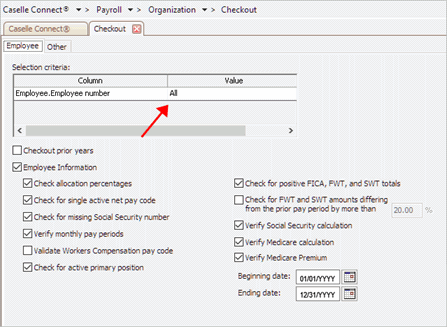
Selection Criteria in Checkout
3. Verify the Beginning Date and Ending Date.
These dates should default to the payroll year being closed. The routine will scan and check data from the selected year.
Important! If these dates are incorrect, DO NOT change them because the dates in Caselle are not correct. Call customer support at (800) 243-8275 for assistance immediately.
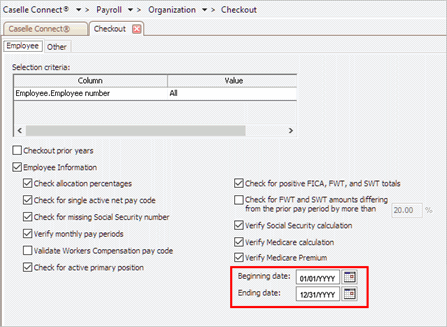
Beginning Date and Ending Date in Checkout
4. Click GO (CTRL+G).
The Checkout report prints.
Here’s a list of common
Checkout errors:
- Employee is missing a Social Security
number. Use Modify Existing Employees to add the employee's Social
Security number.
- Maximum wage limit changed and amounts need to be recalculated.
Call customer support at (800) 243-8275 for assistance.
- Deduction amount does not match the calculated amount. Call customer
support at (800) 243-8275 for assistance.
Did the Checkout report list any errors?
Yes, there are errors on the Checkout report. Call customer support for assistance at (800) 243-8275. Do not continue until the Checkout report is error-free.
No, the Checkout report is error-free. Great news! The pay codes are ready to go. You’re ready for the next step.
STOP!
IMPORTANT! If there are any errors on the Checkout report, contact Customer support for assistance at (801) 243-8275. Do NOT continue until the Checkout report is free of errors.
Before you prepare the W-2 forms for your employees, you should verify that the correct identification numbers for the following items have been defined in the system:
Remember... deduction type pay codes will reduce the wages reported in Boxes 1, 3, 5, and 16 on the W-2.
Verify the Federal ID number is correct. In most organizations, you’ll want to check pay code 76-00 FWT.
Video
Do this...
1. Open Connect Payroll > Organization > Pay Codes.
2. Select the Federal Withholding Pay Code.
Example: 76-00 Federal Withholding Tax
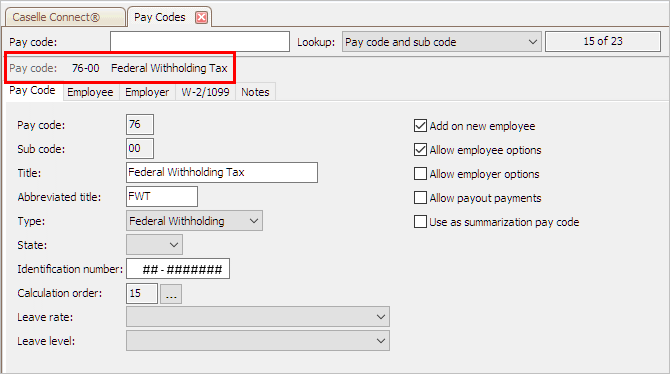
Federal Withholding Tax pay code
3. Locate the Identification Number field.

Federal Withholding Tax pay code > Identification Number field
4. Does the correct Federal ID display in the Identification Number field?
Yes, the correct Federal ID is displayed. That’s good news. Continue to the next step in this section to verify the State Tax ID Number.
No, the Federal ID is not correct. Click on the Identification Number field to enter the correct Federal ID. Now, you’re ready to verify the State Tax ID Number.
The Federal ID number is correct.
Updated 20Dec2017
Verify the State Tax ID Number is correct. In most organizations, you’ll want to look up pay code 77-00 SWT.
Do this...
1. Open Connect Payroll > Organization > Pay Codes.
2. Display the State Withholding Pay Code.
Example: 77-00 State Withholding Tax
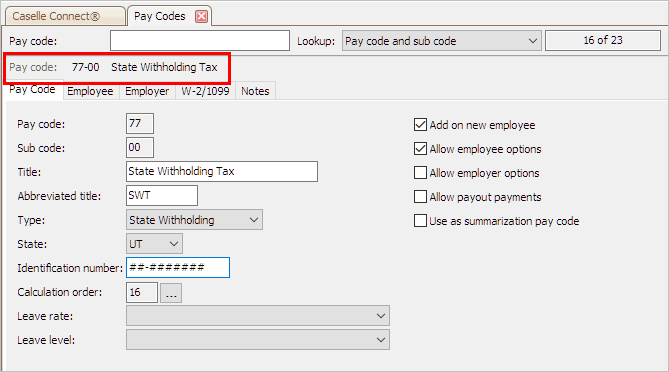
State Withholding pay code
3. Locate the Identification Number field.
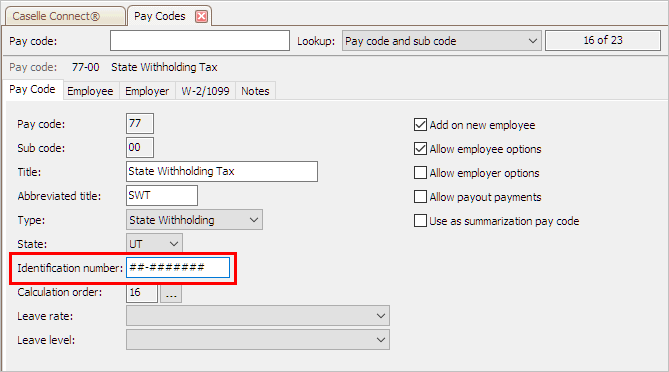
State Withholding pay code > Identification Number field
4. Does the correct State Tax ID Number display in the Identification Number field?
Yes, the correct State Tax ID is displayed. That’s good news. Continue to the next step in this section.
No, the State Tax ID is not correct. Click on the Identification Number field to enter the correct State Tax ID. Now, you’re ready to verify the Employee Social Security Numbers.
The State ID number is correct.
Updated Dec2016
The Used In Calculation designation identifies portions of a pay code that are either subject to certain taxes or exempt from taxes. If the pay code is listed on the Social Security, Medicare, Federal Withholding Tax, or State Withholding Tax, the pay code will be listed on the Use In Calculation tab on the pay code.
Follow these steps to verify the pay codes and percentages on the Used In Calculations tab on each pay code.
What do I do if I don’t know what goes in the W-2 boxes? Caselle can show you where to enter the information, but you’ll need to contact your auditor or visit the irs.gov to find out what information goes in each box.
Reminder! Deduction codes will reduce the amount of wages listed in boxes 1, 3, 5 and 16 on the W-2.
In this section...
Return to the Social Security pay code (74-00) to make sure all of the pay codes that are subject to Social Security are listed on the Social Security pay code.
Videos
Do this...
1. Open Connect Payroll > Organization > Pay Codes.
2. Enter the Social Security pay code (74-00) for your site in the Lookup bar.
3. Click the Employee tab > Used for Calculations subtab.
4. Verify the list includes all of the taxed pay codes.
The list should include pre-tax deductions, all earnings subject to tax, and the deductions that are taken out before taxes are calculated.
You will need to add any taxed pay codes that are not included in the list but should be included on the list.
5. Click the Employer tab > Used for Calculations subtab.
6. Verify the list includes all of the taxed pay codes.
Usually, the pay codes that are subject to Social Security for the employee and employer will be the same pay codes. The most common exception is the Third Party Pay pay code on the employer.
The pay codes that are subject to Social Security have been verified on the Social Security pay code.
Do the same check on the Medicare pay code (75-00) to make sure all of the pay codes that are subject to Medicare are listed on the Medicare pay code.
Do this...
1. Open Connect Payroll > Organization > Pay Codes.
2. Enter the Medicare pay code (75-00) for your site in the Lookup bar.
3. Click the Employee tab > Used for Calculations subtab.
4. Verify the list includes all of the taxed pay codes.
The list should include pre-tax deductions, all earnings subject to tax, and the deductions that are taken out before taxes are calculated.
You will need to add any taxed pay codes that are not included in the list but should be included on the list.
5. Click the Employer tab > Used for Calculations subtab.
6. Verify the list includes all of the taxed pay codes.
Usually, the pay codes that are subject to Medicare for the employee and employer will be the same pay codes. The most common exception is the Third Party Pay pay code on the employer.
The pay codes that are subject to Medicare have been verified on the Medicare pay code.
Updated Dec2016
Do the same check on the Federal Withholding Tax pay code (76-00) to make sure all of the pay codes that are subject to FWT are listed on the FWT pay code.
Do this...
1. Open Connect Payroll > Organization > Pay Codes.
2. Enter the FWT pay code (76-00) for your site in the Lookup bar.
3. Click the Employee tab > Used for Calculations subtab.
4. Verify the list includes all taxed pay codes.
Example: The list should include the 401k Deduction pay code because 401k is exempt from Federal tax.
The list should include pre-tax deductions, all earnings subject to tax, and the deductions that are taken out before taxes are calculated.
You will need to add any taxed pay codes that are not included in the list but should be included on the list.
The pay codes that are subject to Federal Withholding Tax have been verified on the Federal Withholding Tax pay code. You do not need to worry about checking the Used for Calculation list on the Employer’s portion because the employer does not pay Federal Withholding Tax.
Updated Dec2016
Do the same check on the State Withholding Tax (SWT) pay code (77-00) to make sure all of the pay codes that are subject to SWT are listed on the SWT pay code.
Do this...
1. Open Connect Payroll > Organization > Pay Codes.
2. Enter the SWT pay code (77-00) for your site in the Lookup bar.
3. Click the Employee tab > Used for Calculations subtab.
4. Verify the list includes all of the taxed pay codes.
The list should include the 401k Deduction pay code because 401k is exempt from State tax.
The list should include pre-tax deductions, all earnings subject to tax, and the deductions that are taken out before taxes are calculated.
You will need to add any taxed pay codes that are not included in the list but should be included on the list.
The pay codes that are subject to State Withholding Tax have been verified on the State Withholding Tax pay code. You do not need to worry about checking the Used for Calculation list on the Employer’s portion because the employer does not pay State Withholding Tax.
Updated Dec2016
The IRS requires organizations to report specific information in Boxes 10, 11, 12, and 14. Contact your accountant/auditor or the IRS to determine if you have amounts that should be reported in these boxes.
Videos
Reminder... If you have any questions about the information required on your W-2 forms, consult your accountant/auditor for the specific information required for your site.
Note: Caselle Service staff are not payroll tax experts. We can help you put your payroll tax information into the appropriate boxes, but we CANNOT help you determine what amounts need to be report in each box.
In this section...
For amounts that need to be reported in Boxes 10, 11, 12, or 14, you will need to verify the special pay code flags and check the appropriate boxes in Organization > Pay Codes to place the information for each pay code into the correct box on the W-2.
Important! Your accountant or auditor should advise you on the appropriate code to select for each pay code as well as any other information that may be required for each pay code.
The IRS requires organizations to report specific information in Box 12. Contact your accountant/auditor or the IRS to determine if you have amounts that should be report in Box 12.
Example: 401k reports “D” in Box 12, Health Insurance reports “DD” in Box 12.
What about Box 12 codes for health insurance pay codes? Make sure you assign DD to Box 12 on every health insurance pay code.
Do this...
1. Open Connect Payroll > Organization > Pay Codes.
2. Look up the pay code to report in Box 12.
3. Select the W-2/1099 tab.
4. Select the appropriate code that describes the pay code amount from the W-2 Code (Box 12) drop-down list.
To view the Box 12 Codes List, click here.
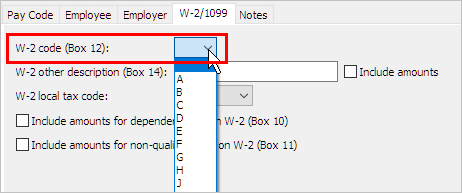
Organization > Pay Codes > W-2/1099 tab
5. Repeat step 3 for each pay code in use at your site with Box 12 requirements.
Tip! Each of these codes and their descriptions, as shown here, can be found by clicking the What’s This? Help button (CTRL+W) and then moving the mouse over the W-2 Code (Box 12) field. You can also use the Box 12 Codes List, located below, or visit the irs.gov website for more information.
The W-2 Box 12 code is saved.
Updated Dec2016
Other tax information is reported in Box 14. Box 14 descriptions may include the following items: Contributions to Employee Pension Plans, Union Dues, Life or Health Insurance Premium Payroll deductions, Moving Expenses, etc.
Box 14 descriptions may include the following items: Contributions to Employee Pension Plans, Union Dues, Life or Health Insurance, Premium Payroll deductions, Moving Expenses, etc.
Reminder! If you have any questions about the information required on your W-2 forms, consult your accountant/auditor for the specific information required for your site.
Do this...
1. Does your site require a description for Box 14?
Yes, my site requires a description for Box 14. Enter it in the W-2 Other Description (Box 14) field. If you need to include the Box 14 amount, select the Include Amounts checkbox.
No, my site does not require a description for Box 14. Continue to the next step.
2. Is the pay code for dependent care? For example, such as a cafeteria plan payroll deduction.
Yes, the pay code is for dependent care. Select the Include Amounts for Dependent Care (Box 10) checkbox.
No, the pay code is not for dependent care. Continue to the next step.
3. Are you required to print the total amount of distributions to an employee for a non-qualified deferred compensation plan?
Yes, I need to print this information. Select the Include Amounts for Non-Qualified Plan on W-2 (Box 11) checkbox.
No, I do not need this information. Continue to the next step.
You’re ready to run Checkout.
Updated Dec2016